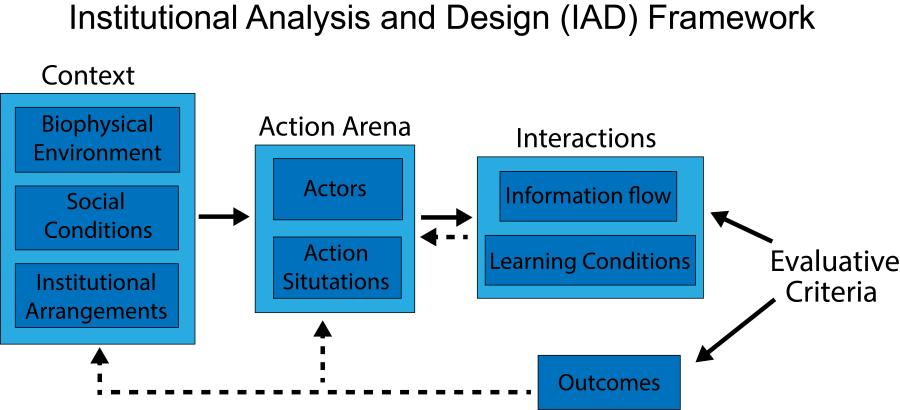
A downloadable version of this explainer is available here:
Governance refers to a system or set of “rules” designed to control or influence something in a political, social, economic, business, environmental, or other context. In the study of socio-environmental systems and problems, governance can be used as a framework for analysis, typically of “institutions” within which decisions occur (McGinnis and Ostrom 2014). At its heart, governance aims to influence an individual’s behavior or the collective actions of a group (Bennett and Satterfield 2018).
Governance is considered “formal” if it is transparent to all and has specified rules as in laws and policies that determine decisions and management. Examples include preventative measures (e.g., regulations, conflict resolution guidelines) or punitive measures (e.g., fines). Courts of law, governmental bodies, and police agencies are often the arenas in which formal governance plays out. The people who set the laws, enforce policies/regulations, or police for safety are referred to as state actors and often represent a government.
Quite often, however, governance is “informal” such as norms, practices, and casual agreements that dictate decisions, behaviors, and customs. Group interactions, social networks, shaming of peers, family practices, etc. are the modes in which informal governance takes place. The term non-state actors refers most often to those people, institutions, and groups who are involved in informal governance and includes members of civil society, non-governmental organizations, the media, and others.

The Pioneering Role of Elinor Ostrom
Former Professor and Nobel Laureate Elinor Ostrom (1933–2012) conducted empirical research based on her observations of common-pool resources, which are natural resources available for all people to share, such as clean air, water, and forests. Her publication of Governing the Commons in 1990 was pivotal in showing that the “Tragedy of the Commons” (Hardin 1968)—the belief that with unfettered access a resource will ultimately be depleted—wasn’t inevitable. Rather, “good” community-based management can result in sustainable natural resources. Her research showed that if people interact cooperatively with one another and with resources at their local scales, they can sustain resources. She championed what is called institutional analysis, which involves identifying the social and ecological components involved in a problem related to the use of natural resources; the current governance mode for the resources; and potential options for a more equitable and sustainable governance strategy.
Ostrom’s use of the word “institutions” goes beyond just formal governance because it can also refer to a variety of “actors” (individuals, representatives of groups, organizations) who shape decisions through informal processes. Identifying the characteristics of both the environmental setting and social dynamics is an important part of institutional analysis. Epstein et al. (2022) provide a nice introduction to institutional analysis along with multiple examples.

Research on Socio-Environmental Governance
The study of how different societies govern in relation to their natural resources is a large, growing area of research. Of particular interest is understanding how environmental and social contexts determine the most effective governance strategies for protecting or recovering public goods. Studies include, for example, a focus on who participates in decision making and how their power is distributed (e.g., Newig et al. 2023, Albas et al. 2023). Another important topic is understanding how legal, economic, and democratic tools contribute to ensuring adaptive governance—namely, governance that can change in response to social and environmental changes or contexts (e.g., DeCaro et al. 2017, Li and Jin 2023). Polycentric governance—multiple decision-making bodies that have some autonomy but share in governance—has been prominent in research to find sustainable solutions to complex socio-environmental problems (e.g., Acton et al. 2021, Morrison et al. 2023). And while only a subset of research on corporate governance is focused on socio-environmental systems (Bebbington et al. 2024), there is a broad, growing body of work in relation to environmental sustainability (e.g., Ao et al. 2023, Fu et al. 2023, Ahmad et al. 2024).
References
- Ahmad, H., Yaqub, M., & Lee, S.H. (2024). Environmental-, social-, and governance-related factors for business investment and sustainability: A scientometric review of global trends. Environment, Development, and Sustainability, 26, 2965–2987. https://doi.org/10.1007/s10668-023-02921-x
- Alblas, E.C., & van Zeben, J.A.W. (2023). Collaborative agri-environmental governance in the Netherlands: a novel institutional arrangement to bridge social-ecological dynamics. Ecology & Society, 28(1). https://doi.org/10.5751/ES-13648-280128
- Acton, L., Gruby, R.L., & Nakachi, A. (2021). Does polycentricity fit? Linking social fit with polycentric governance in a large-scale marine protected area. Journal of Environmental Management, 290, 112613. https://doi.org/10.1016/j.jenvman.2021.112613
- Ao, X., Ong, T.S., & Teh, B.H. (2023). Corporate sustainability development strategy and corporate environmental governance—The moderating role of corporate environmental investments. International Journal of Environmental Research and Public Health, 20(5), 4528. https://doi.org/10.3390/ijerph20054528
- Bebbington, J., Larrinaga, C., & Michelon, G. (2024). A socio-ecological approach to corporate governance. In M. Magnan & G. Michelon (Eds.), Handbook on Corporate Governance and Corporate Social Responsibility (pp. 359-370). Edward Elgar Publishing. https://doi.org/10.4337/9781802208771.00038
- Bennett, N.J., & Satterfield, T. (2018). Environmental governance: A practical framework to guide design, evaluation, and analysis. Conservation Letters, 11(6), e12600. https://doi.org/10.1111/conl.12600
- Decaro, D., Chaffin, B.C., Schlager, E. et al. (2017). Legal and institutional foundations of adaptive environmental governance. Ecology & Society, 22(1). https://doi.org/10.5751%2FES-09036-220132
- Epstein, G., Villamayor-Tomas, S., & Schoon, M. (2022). Institutional analysis. In R. Biggs, A. De Vos, R. Preiser, H. Clements, K. Maciejewski & M. Schlüter (Eds.), The Routledge Handbook of Research Methods for Social-Ecological Systems. Routledge International Handbook, Routledge Press. New York, NY. https://doi.org/10.4324/9781003021339
- Fu, H., Jiang, Q., Cifuentes-Faura, J. & Chen, Q. (2024). Corporate environmental governance and firm value: beyond greenwashing for sustainable development. Environment, Development, and Sustainability. https://link.springer.com/article/10.1007/s10668-023-04375-7
- Hardin, G. (1968). The Tragedy of the Commons. Science, 162(3859), 1243-1248. https://www.science.org/doi/10.1126/science.162.3859.1243
- Li, R., & Jin, W. 2023. The role of the Yangtze River Protection Law in the emergence of adaptive water governance in China. Ecology & Society, 28(1). https://doi.org/10.5751/ES-13694-280132
- McGinnis, M.D., & Ostrom, E. 2014. Social-ecological system framework: initial changes and continuing challenges. Ecology and Society, 19(2): 30. http://dx.doi.org/10.5751/ES-06387-190230
- Morrison, T.H., Bodin, Ö., Cumming, G.S. et al. (2023). Building blocks of polycentric governance. Policy Studies Journal, 51(3), 475-499. https://doi.org/10.1111/psj.12492
- Newig, J., Jager, N.W., Challies, E., & Kochskämper, E. (2023). Does stakeholder participation improve environmental governance? Evidence from a meta-analysis of 305 case studies. Global Environmental Change, 82, 102705. https://www.sciencedirect.com/science/article/pii/S0959378023000717